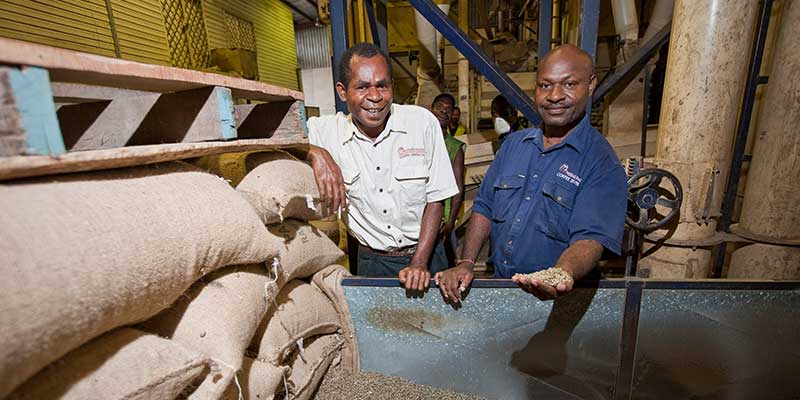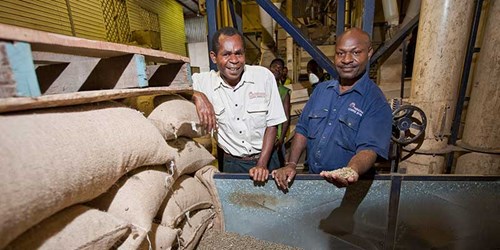|
|
Papua New Guinea (PNG) is one of the most culturally diverse countries in the world with more than 800 distinct languages and over 1,000 tribes (mostly Melanesian with some Micronesian and Polynesian communities).
Most of the population comprises subsistence farmers with just 15% living in urban areas. The PNG mainland and its six hundred islands have a total land area of 452,860 square kilometres. It is the largest of the Pacific Island nations.
It occupies the eastern half of the mainland island of New Guinea with three additional islands (New Britain, New Ireland and Bougainville) and over 600 lesser islets and atolls to the north and east. The main islands are volcanic in origin with rugged interiors rising to an elevation of 4,496 metres.
The climate is tropical, with high temperatures and humidity levels. Tropical forests that covered much of the country are rapidly being logged.
At the same time, the connections between people and their land are very significant and central to their identity.
Economic Overview
PNG is a rapidly growing economy, strategically bridging Asia and the Pacific.
In recent years, growth has been driven by natural gas and mining (including gold and copper) projects that have provided new opportunities for local businesses and foreign companies.
Much of the population of PNG relies on subsistence farming and the economy remains dominated by two sectors: The agricultural, forestry and fishing sector, which informally engage the majority of the labour force.
The minerals and energy extraction sector, which accounts for the majority of export earnings and Gross Domestic Product. Take a look at how Pacific Trade Invest (PTI) Australia’s work with bilum weavers is building a sustainable export pathway for weaving communities.
If you are interested in investment opportunities in PNG explore PTI Australia's Investment Directory.
Brief History
Archaeological evidence indicates that humans arrived on New Guinea at least 60,000 years ago.
In 1526, Portuguese sailor Jorge de Meneses was the first European visitor and he named one of the islands ‘ilhas dos Papuas’ or ‘land of fuzzy-haired people’.
Spanish explorer Inigo Ortiz de Retes named the other main island New Guinea in 1546, because the islanders resembled the people of Guinea in Africa.
In 1885, the eastern half of the island was divided between Germany (north) and England (south). During World War I (1914–18), Australia occupied the German area, and continued to administer the combined areas until full independence was gained on 16 September 1975.
Culture
The people are largely descendants of the Papuans – Melanesians include inhabitants from island countries such as Fiji, New Caledonia, Vanuatu, Solomon Islands and PNG. More than a third of Papua New Guineans is in the rugged Highlands.
The traditional Melanesian cultures are kept alive in elaborate rituals that accompany important social events, including deaths, feasts, marriages, compensation ceremonies and initiation rites.
These elaborate ceremonies are normally presided over by the elders of the clan, with warriors painted and decorated in bright colours, feathers and shells. Today, each of the twenty provinces have their own cultural festivals and regional shows where groups are invited to perform, and visitors have the opportunity to glimpse the many visual and performing arts of PNG.
The most popular shows include the Hiri Moale Festival held in Port Moresby every September, the Mount Hagen show held annually in August, and the Goroka Show also held every September that attracts tourists from all over the world. PNG’s art forms are as diverse as they are distinctive.
In a country where language varies from village to village, it can be expected that artistic expression will differ in style just as dramatically. Pottery, weapons, carvings, basketwork and musical instruments are produced by different people from different places in accordance with their traditional skills and beliefs.
Politics
- Prime Minister: James Marape
- Head of state: Queen Elizabeth II, represented by a Governor-General
PNG is an independent Commonwealth nation. It is a parliamentary democracy with a governor-general representing the British Crown, a prime minister, a cabinet and a 109-member popularly elected, unicameral parliament.
The legal system is based on English common law. There is a Supreme Court in which the chief justice is appointed by the governor-general on the recommendation of the National Executive Council.
There are three levels of government – national, provincial and local. The National Parliament is a 111-member unicameral legislature elected for five-year terms by universal suffrage. The prime minister is appointed and dismissed by the governor-general on the proposal of parliament.
Members of the National Parliament are elected from 89 single-member electorates and 22 regional electorates. The regional electorates correspond to PNG’s 20 provinces, plus the Autonomous Region of Bougainville and the National Capital District. Members from regional electorates also serve as provincial governors.
Each province has its own provincial assembly and administration.
Sources
--------------------
Published December 2017




